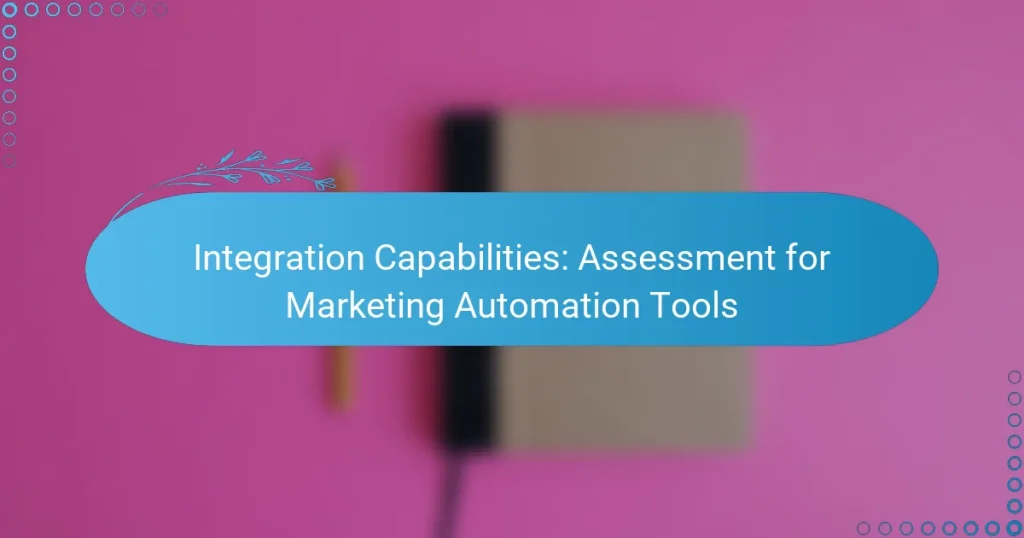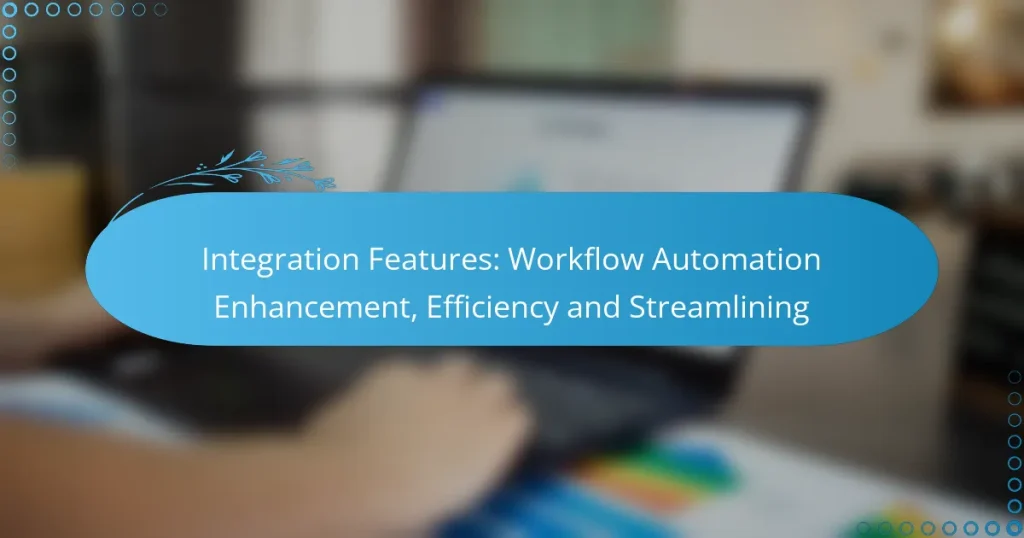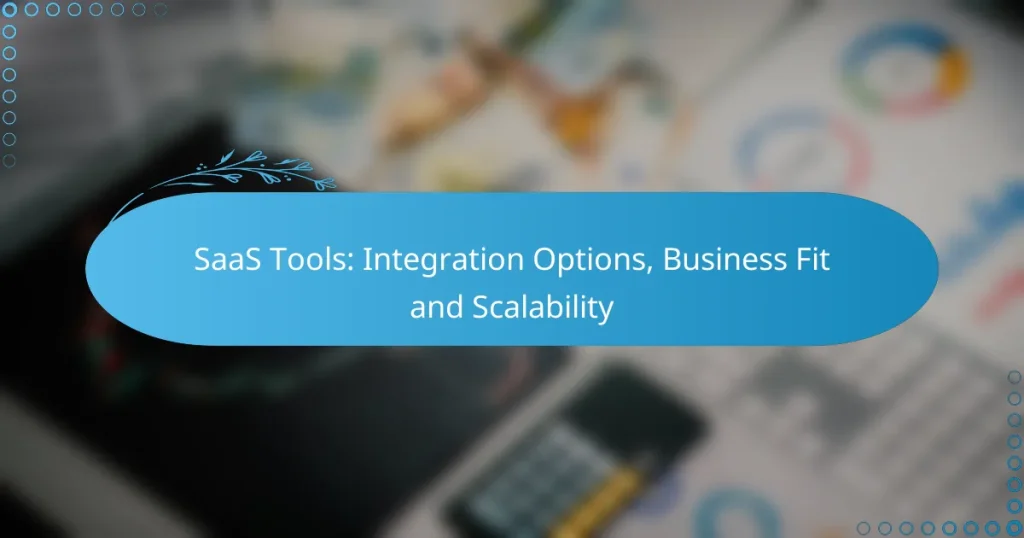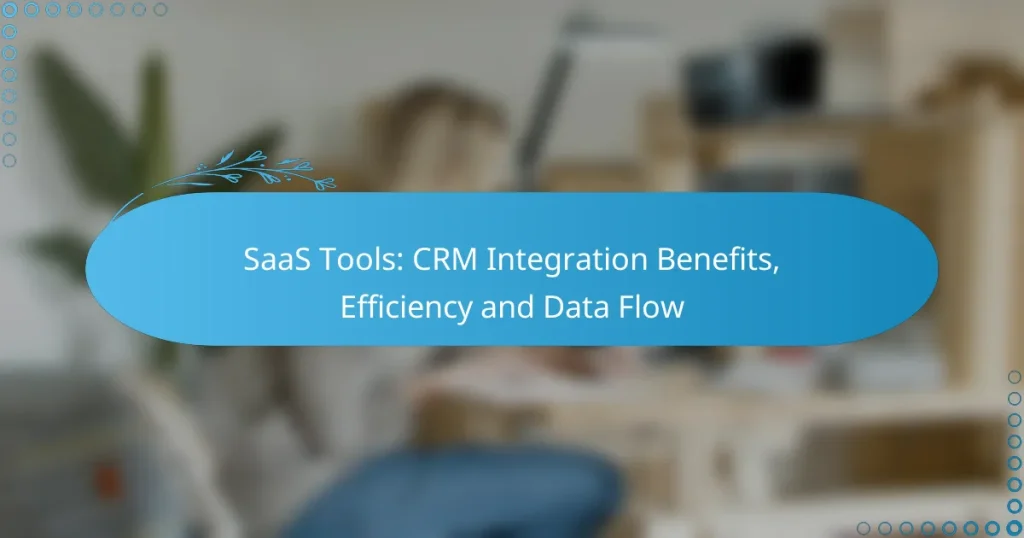In today’s fast-paced business environment, selecting a SaaS business management tool with strong integration capabilities is essential for maximizing efficiency. Tools like Monday.com, Asana, Zoho One, Salesforce, and HubSpot offer seamless connectivity with various applications, enabling streamlined operations and improved data sharing. Key features to consider include API access, third-party app support, and data synchronization, all of which enhance functionality and reduce errors.
SaaS Applications: Integration Best Practices, IT Compatibility and Security
Integration Features: Workflow Automation Enhancement, Efficiency and Streamlining
SaaS Tools: Integration Options, Business Fit and Scalability
SaaS Tools: CRM Integration Benefits, Efficiency and Data Flow
Third-Party Integration Options: Evaluation, Flexibility and Cost
API Integration Features: Comparison, Usability and Performance
What are the best SaaS business management tools for integration in the UK?
The best SaaS business management tools for integration in the UK include platforms that offer seamless connectivity with other applications, enhancing workflow efficiency. Key options like Monday.com, Asana, Zoho One, Salesforce, and HubSpot provide various integration capabilities tailored to different business needs.
Monday.com
Monday.com is a versatile work operating system that allows teams to manage projects and workflows effectively. Its integration capabilities include connections with popular tools like Slack, Google Drive, and Microsoft Teams, enabling users to centralize their operations.
When using Monday.com, consider its automation features, which can save time on repetitive tasks. Users can set up triggers and actions to streamline processes, ensuring that team members stay informed without manual updates.
Asana
Asana is a project management tool that excels in task tracking and team collaboration. It integrates with various applications, such as Zoom, Dropbox, and GitHub, making it easier for teams to coordinate their efforts across different platforms.
To maximize Asana’s integration benefits, utilize its API for custom connections or explore pre-built integrations. This flexibility allows businesses to tailor the tool to their specific workflows, enhancing productivity.
Zoho One
Zoho One is an all-in-one suite that includes a range of applications for business management. Its integration capabilities allow users to connect with third-party apps like Mailchimp and QuickBooks, providing a comprehensive solution for managing various business functions.
Leverage Zoho One’s unified dashboard to monitor performance across different applications. This centralization helps businesses maintain a clear overview of their operations, facilitating better decision-making.
Salesforce
Salesforce is a leading customer relationship management (CRM) platform known for its robust integration capabilities. It connects with numerous applications, including marketing tools and accounting software, allowing businesses to create a cohesive ecosystem.
When implementing Salesforce, consider utilizing its AppExchange for additional integrations that can enhance functionality. This marketplace offers a wide range of third-party applications tailored to various business needs.
HubSpot
HubSpot is a popular inbound marketing and sales platform that offers extensive integration options. It connects seamlessly with tools like Shopify, WordPress, and social media platforms, enabling businesses to streamline their marketing efforts.
To fully benefit from HubSpot’s integrations, take advantage of its workflows feature to automate marketing tasks. This can help improve lead nurturing and customer engagement, driving better results for your campaigns.
How do integration capabilities enhance SaaS business management?
Integration capabilities significantly enhance SaaS business management by allowing different software applications to communicate and share data seamlessly. This connectivity streamlines operations, reduces errors, and improves overall efficiency.
Streamlined workflows
Streamlined workflows occur when various SaaS tools work together without manual intervention. For instance, integrating a project management tool with a time tracking application can automatically update project timelines based on logged hours, reducing administrative tasks.
To achieve streamlined workflows, prioritize integrations that align with your core business processes. Evaluate tools that offer APIs or pre-built connectors to facilitate these connections easily.
Improved data accuracy
Improved data accuracy is a key benefit of integration capabilities, as it minimizes the risk of human error associated with manual data entry. When systems are integrated, data is automatically synchronized across platforms, ensuring that all users access the same up-to-date information.
Consider using integration platforms that support data validation and error-checking features. This can help maintain data integrity and provide insights based on reliable information.
Increased productivity
Increased productivity is a direct result of automation enabled by integration capabilities. By reducing repetitive tasks, employees can focus on higher-value activities, such as strategic planning and customer engagement.
To maximize productivity gains, identify bottlenecks in your current processes and seek integrations that address these pain points. Regularly review and optimize your integrations to ensure they continue to meet evolving business needs.
What are the key integration features to look for in a SaaS tool?
When evaluating a SaaS business management tool, key integration features include API access, third-party app support, and data synchronization. These capabilities ensure that the tool can seamlessly connect with other software and systems, enhancing overall efficiency and functionality.
API access
API access is crucial as it allows external applications to communicate with the SaaS tool. A well-documented API enables developers to build custom integrations, automate workflows, and extend the tool’s functionality. Look for APIs that support REST or GraphQL, as these are widely used and offer flexibility.
Consider the API rate limits and authentication methods as well. A tool with generous rate limits and secure authentication protocols, such as OAuth, will provide a smoother integration experience. Always check if the API supports webhooks for real-time data updates.
Third-party app support
Third-party app support refers to the ability of the SaaS tool to integrate with popular applications used in your business ecosystem. This includes CRM systems, accounting software, and project management tools. A wide range of integrations can significantly enhance productivity by allowing data to flow seamlessly between platforms.
Evaluate the marketplace or library of integrations offered by the SaaS provider. Tools that support well-known applications like Salesforce, QuickBooks, or Slack are often more valuable. Additionally, check for pre-built connectors that simplify the integration process without requiring extensive development work.
Data synchronization
Data synchronization ensures that information is consistently updated across all integrated systems. This feature is vital for maintaining data integrity and avoiding discrepancies. Look for tools that offer real-time or near-real-time synchronization to keep all platforms aligned.
Consider how the SaaS tool handles data conflicts and duplicates during synchronization. Effective conflict resolution mechanisms can prevent data loss and ensure that your team always has access to the most accurate information. Regularly review synchronization settings to adapt to changing business needs.
How do SaaS tools integrate with existing systems in UK businesses?
SaaS tools integrate with existing systems in UK businesses primarily through APIs, custom connectors, and middleware solutions. These methods enable seamless data exchange and functionality enhancement, allowing businesses to leverage their current software investments while adopting new cloud-based services.
Custom connectors
Custom connectors are tailored solutions that link specific SaaS applications with existing systems. Businesses often choose this option when pre-built integrations do not meet their unique requirements. Developing custom connectors typically involves using APIs to facilitate data transfer and ensure compatibility between different platforms.
When considering custom connectors, businesses should evaluate the cost, development time, and ongoing maintenance. While they can provide a perfect fit for specific needs, they may require significant technical resources and expertise.
Pre-built integrations
Pre-built integrations are ready-made solutions that connect popular SaaS tools with existing software systems. These integrations are often provided by the SaaS vendors themselves or third-party developers and can significantly reduce implementation time. They typically require minimal configuration, making them an attractive option for businesses looking for quick deployment.
However, it is essential to ensure that the pre-built integrations align with the specific needs of the business. While they can save time and resources, they may not offer the flexibility that custom solutions provide.
Middleware solutions
Middleware solutions act as intermediaries that facilitate communication between different software applications. They can connect SaaS tools with legacy systems, allowing for data synchronization and process automation. Middleware is particularly useful for businesses with complex IT environments that involve multiple systems and data sources.
When implementing middleware, businesses should consider factors such as scalability, performance, and compatibility with existing systems. While middleware can streamline integration efforts, it may introduce additional complexity and require ongoing management to ensure optimal performance.
What are the costs associated with SaaS integration tools?
The costs associated with SaaS integration tools can vary widely based on features, usage, and vendor pricing models. Key expenses typically include subscription fees and implementation costs, which are essential to consider for budgeting and planning.
Subscription fees
Subscription fees for SaaS integration tools often follow a tiered pricing model based on the number of users or features required. Monthly fees can range from around $20 to several hundred dollars, depending on the complexity of the integration and the size of your organization.
When evaluating subscription options, consider the total cost of ownership, including any additional charges for exceeding usage limits or accessing premium features. Some providers may offer discounts for annual commitments, which can lead to significant savings.
Implementation costs
Implementation costs can vary significantly based on the complexity of the integration and the resources required. These costs may include hiring consultants, training staff, and customizing the tool to fit your specific business needs. Expect to allocate anywhere from a few hundred to several thousand dollars for a successful implementation.
To manage implementation costs effectively, assess your internal capabilities and determine whether you can handle parts of the integration in-house. Additionally, look for vendors that provide comprehensive support and resources to minimize external expenses.






